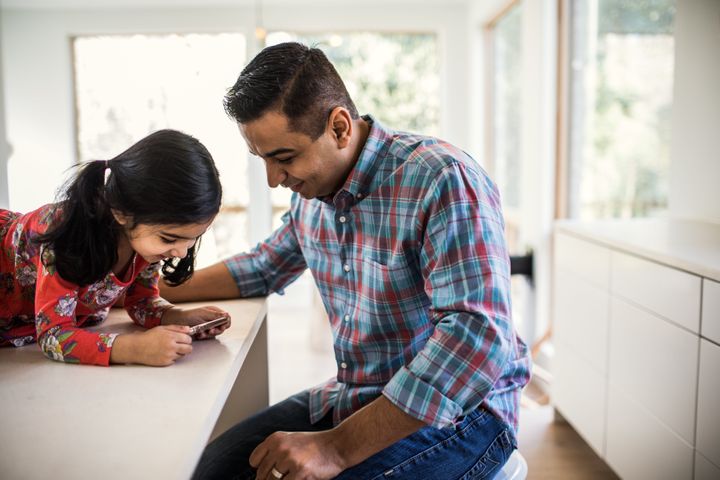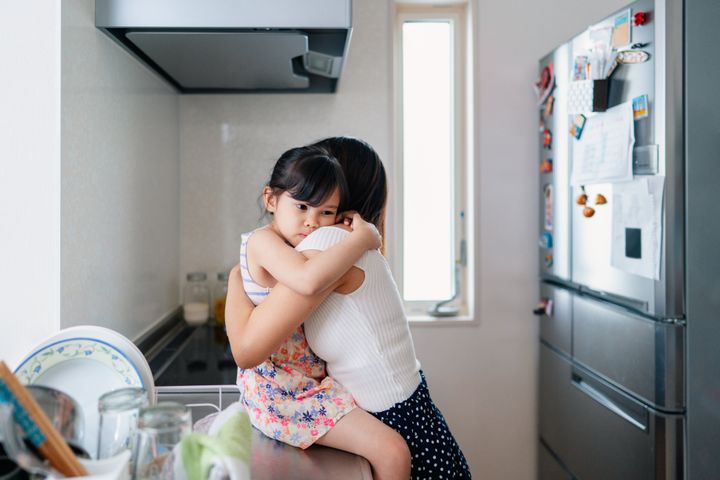News
What To Say If Your Kid Says
Few words are more heart-wrenching to hear from your child than “I wish I didn’t look the way I do” or “I wish I wasn’t my race.”
Those words can spring from a variety of painful experiences: A taunting on the playground for having “different” hair. The slow realization that all their favorite library books feature characters who look nothing like them. Or, later on, the microaggression of a classmate saying, “You’re pretty for a ____ girl.”
Whatever drives them, hearing the words from your child bowls you over as a parent. But the reality is, kids are far more racially aware than many parents realize: A 2020 study showed that children notice race several years before adults want to talk about it. By preschool age, children develop racial biases — which aren’t always consistent with the beliefs of the adults in their lives.
Statements like ‘I don’t want to be my race anymore’ are likely a warning sign of growing internalized racism
Indeed, delays in important conversations about racial identity could make it more difficult to change children’s misperceptions about themselves or racist beliefs, according to the 2020 study.
“Children are capable of thinking about all sorts of complex topics at a very young age,” said Jessica Sullivan, the study’s co-author and associate professor of psychology at Skidmore College. “Even if adults don’t talk to kids about race, children will work to make sense of their world and will come up with their own ideas, which may be inaccurate or detrimental.”
In a society that elevates white culture over others and encourages assimilation at all costs, it’s easy to see how a young child of color may come to believe that their own culture is inferior, which could develop into internalized racism.
Growing up Black in Liberty County, Georgia, Kwanzaa Wallace never told his parents “I wish I wasn’t Black” but he “definitely thought it a lot,” he told HuffPost.
“When I was a kid, I was very much into ‘alternative things’ as a black person, like anime,” said Wallace, who works as a sales associate. “It definitely took some time to grow into and learn to balance that aspect of my identity with my ‘blackness.’”
Luckily for Wallace, from an early age his mom had broached age-appropriate conversations about race and the need for self-love ― conversations meant to prepare him for a world full of inequalities and almost limitless opportunities for self-loathing.
“My mother gave me many ‘briefings’ about race and how differently I was likely to be perceived by other children roughly around the ages where I was beginning to start elementary school,” Wallace said.
As he got more mature, the conversations did as well. “She started telling me, ‘Be aware not to do certain things because you’ll be seen as different primarily because you’re Black. You have to come off as non-threatening as possible when you’re out.’”
Wallace’s mom was ahead of the curve in her approach to these conversations, said Jacqueline Douge, a pediatrician and author of the young adult book “Learning to Love All of Me.” She probably could have even started them earlier.
“What we see is that children ages 2 to 4 can internalize racism, and parents as children’s first teachers have the opportunity to help children understand and process these issues,” she told HuffPost. “There is also an opportunity to model and challenge racial bias and stereotypes through kindness and empathy.”
But for every parent who handles these heavy conversations with kindness and empathy, there’s another who falls short.
Growing up in Indianapolis, Brittany, a biracial college student who asked to use only her first name to protect her privacy, vividly recalls coming to her parents when she was little and telling them she wished she looked more white than Black.
“That one day I told my parents I wanted to be fully white with straight blond hair and blue eyes, and instead of them addressing that topic they just laughed,” she told HuffPost. “I’d say I wished I wasn’t half Black until late high school.”
Her parents’ reaction ― and their general dismissiveness of how her Blackness would impact her life ― made it nearly impossible for Brittany to work through her growing internalized racism.
“I’ve learned it’s extremely important that parents ― especially white parents ― don’t create the mindset of ‘not seeing color,’” she said. “You have to address those differences because if you don’t, you ignore the ingrained racism and colorism in our society. That mindset dismisses different identities and cultures.”
Here’s the right way to respond as a parent
If your child comes to you and says “I wish I were a different race,” the best thing you can do as a parent is to simply hear them out.
“Sometimes our first response as parents is to react but sometimes our children want to be heard and share their feelings. By listening, you validate their feelings,” Douge said.
The goal is to understand their experience and get the context you need in order to thoughtfully respond to specific questions and feelings they’re having, she said.
Resist the urge to interrupt, to quiet their concerns or to correct what they’ve said, noted KaeLyn Rich, a staff writer at Autostraddle.com and a Korean adoptee raised by a white family.
“As a parent now myself, I know our urge is to soothe and protect,” she said. “However, just telling a child they are beautiful or special or perfect the way they are isn’t enough.”
Instead, she said, ask questions and find out where the comment is coming from.
“What’s going on at the root of the internalized racism?” she said.
“Help them believe that their feelings are real and normal, while also talking about why it’s wonderful to be [your race/ethnicity] and how you came to love yourself.”
– KaeLyn Rich
Growing up in a white-dominant rural community, where pretty much the only other Korean person she knew was her sister, Rich said she often wished she was white.
“I hated how I looked, had no friends who looked like me, had only white role models, and just wanted to be ‘normal,’” she said. “I didn’t have a strong tie to my heritage growing up and I think that was a large part of why I had such a hard time identifying with being Korean, which has carried over into adulthood.”
Rich’s parents encouraged her to be proud of her Korean heritage, but these conversations would have had more impact if they had tried to relate to her struggles on a personal level.
“We have all felt this way at some point or at least understand where the shame that manifests as internalized racism comes from,” she said. “Help them believe that their feelings are real and normal, while also talking about why it’s wonderful to be [your race/ethnicity] and how you came to love yourself, why who they are is perfect.”

If your child brought up this topic because they were discriminated against or told something racist, don’t be afraid to call it out as such, said Kevin Nadal, a professor of psychology at City University of New York and author of “Microaggressions and Traumatic Stress.”
“Parents shouldn’t shy away from teaching kids at age-appropriate levels about discrimination,” he said. “Telling a preschool kid that sometimes people mistreat others because of their skin color or hair texture prepares them for the realities of the world.”
It also teaches kids the importance of social justice and how they can stand up against unfairness and hate. If bullying is part of the issue, give them strategies for dealing with a bully and getting support. Involve school staff if necessary.
Surround them with TV shows, books and movies with stories that mirror their experiences
Listen to and validate your child’s feelings in the moment, but beyond that, make a project of building up their ethnic and racial pride. Teach them about their cultural history, which may get the short shrift in history class. When you delve into the history, don’t just highlight the struggles of your people, talk about the wins and success stories worth emulating, too.
Talk to your kids from an early age about the beauty and value of race and ethnicity, Nadal said.
“When kids are toddler-age, parents can talk to them about the beauty in different racial and cultural groups,” he said. “In doing so, kids recognize that there is value and beauty in diversity, while also learning that it is OK and encouraged to talk about race.”
Representation matters here, too. If you aren’t already doing it, surround them with media that features characters that look like them.
That alone makes a huge difference in combating racial self-loathing, said Sai Seshadri, a technical project manager in New York City.
“As a child, I always thought to myself, ‘I wish I weren’t Indian,’ in part because the media and the environment I was in made me believe that in order to be considered beautiful or popular or successful, you had to be white,” she told HuffPost.
Seeing more Indian and South Asian faces on her TV screen would have been a game changer for her growing up.
“There wasn’t any representation to be found, from every book protagonist to television shows to movies,” she said. “I look back at this, though, and it makes me feel very sad that I felt this way ― now, I couldn’t be more proud of my skin color or race.”
“As parents, it’s your job to do everything you can to counter [negative messages] so that kids develop a healthy sense of identity and cultural pride.”
– Kevin Nadal
Representation isn’t just about what you put on TV or read to your child, though. Surround them with members of your community who look like them, Nadal said, especially if you live in a predominantly white neighborhood.
“Provide them with examples of older kids of their same racial groups, who they can look up to,” he said. “And make sure they have diverse friends in general, or that at the bare minimum they aren’t the only kid of color in their peer groups.”
When young kids see themselves as different ― especially from the outset at an early age ― they may internalize that negative message for the rest of their lives. It’s hard work as a parent, but there’s plenty of opportunity to course-correct, Nadal said.
“As parents, it’s your job to do everything you can to counter that, so that kids develop a healthy sense of identity and cultural pride,” the psychologist said.
This story is part of a HuffPost Parents project called “I See Me,” a series for parents and kids on the power of representation. We know how important it is for kids to see people who look like them on the biggest stages, including politics, sports, entertainment and beyond. Throughout February, we’ll explore the importance of representation in teaching kids about difference, acceptance, privilege and standing up for others.

